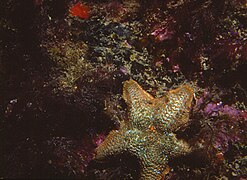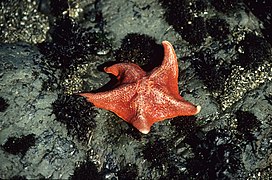Asterinidae
| Asterinidae | ||||||||||
|---|---|---|---|---|---|---|---|---|---|---|

|
||||||||||
| Systematics | ||||||||||
|
||||||||||
| Scientific name | ||||||||||
| Asterinidae | ||||||||||
| Gray , 1840 |
Asterinidae is the name of a family of starfish in the order of the flap stars (Valvatida), which is represented in all oceans from the deep sea to the shore zones and from the polar regions to the tropics. About 150 species are known.
description
The Asterinidae are usually small to very small, flattened starfish with usually five very short arms, which often gives them a pentagonal shape. The edge of these starfish is thin and has only very small, inconspicuous side plates. The lime flakes in the skin on the top are crescent-shaped, giving it the look of a knitted pattern.
Some types
Most species of the Asterinidae are small and live hidden under stones, in crevices or other hiding places. The Asterinidae is the smallest known starfish, Asterina phylactica, which is only about 1 cm in size . Only in the deep sea there are large species, in the genus Anseropoda up to 45 cm.
Some species - among others in the genera Meridiastra and Aquilonastra - can reproduce asexually through Fissiparie , so that a single larva is sufficient to colonize a new habitat. Like other starfish, most species of the Asterinidae develop as free-swimming Bipinnaria larvae. In the genus Asterina , to which hermaphrodites belong, there are transitions to direct development. The embryos of Asterina gibbosa feed on egg yolks and hatch directly as Brachiolaria larvae, which immediately undergo metamorphosis into starfish. Other species of this genus such as Asterina phylactica and Asterina pancerii, on the other hand, hatch their young, so that finished starfish leave the mother's care.
Most of the species in this family feed on detritus, carrion , dead plants or the coating of the rocks consisting of algae and bacteria , for which the starfish turn out the stomach and press it against the ground. There are, however, some carnivores : Stegnaster inflatus Hutton , 1872, forms a kind of tent with its arms, into which some animals crawl in search of shelter. At the right moment the starfish drops and devours the prey, mostly small crabs.
Genera
According to O'Loughlin & Waters (2004) there are 116 species in 21 genera in the Asterinidae family, while there are 150 species in 25 genera according to the World Register of Marine Species . These are:
- Ailsastra O'Loughlin & Rowe, 2005
- Allopatiria Verrill, 1913
- Anseropoda Nardo, 1834
- Aquilonastra O'Loughlin in O'Loughlin & Waters, 2004
- Asterina Nardo, 1834
- Asterinides Verrill, 1913
- Asterinopsis Verrill, 1913
- Callopatiria Verrill, 1913
- Cryptasterina Dartnall & al. 2003
- Disasterina Perrier, 1875
- Indianastra O'Loughlin in O'Loughlin & Waters, 2004
- Kampylaster Koehler, 1920
- Manasterina H.L. Clark, 1938
- Meridiastra O'Loughlin, 2002
- Nepanthia Gray, 1840
- Paranepanthia Fisher, 1917
- Parvulastra O'Loughlin in O'Loughlin & Waters, 2004
- Patiria Gray, 1840
- Patiriella Verrill, 1913
- Pseudasterina Aziz & Jangoux, 1985
- Pseudonepanthia A.H. Clark, 1916
- Pseudopatiria O'Loughlin in O'Loughlin & Waters, 2004
- Stegnaster Sladen, 1889
- Tegulaster Livingstone, 1933
- Tremaster Verrill, 1880
- Ctenaster L. Agassiz, 1836
- Desmopatiria Verrill, 1913
Cryptasterina sp.
literature
- PM O'Loughlin, JM Waters: A molecular and morphological revision of genera of Asterinidae (Echinodermata: Asteroidea) . In: Memoirs of Museum Victoria . 61, No. 1, 2004, pp. 1-40.
- Maria Byrne: Life history diversity and evolution in the Asterinidae . In: Integrative and Comparative Biology . 2006, pp. 1-12. doi : 10.1093 / icb / icj033 .
Web links
- Christopher L. Mah: Better know The Asterinidae: Familiar & Unfamiliar! . 19th November 2015.
- Christopher L. Mah: Asterinidae Gray, 1840 . In: Christopher L. Mah: World Asteroidea database. World Register of Marine Species , 2015.










